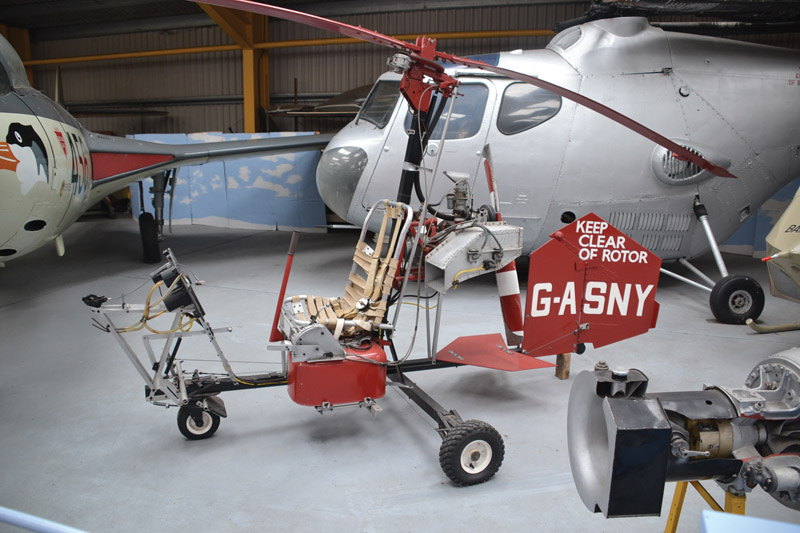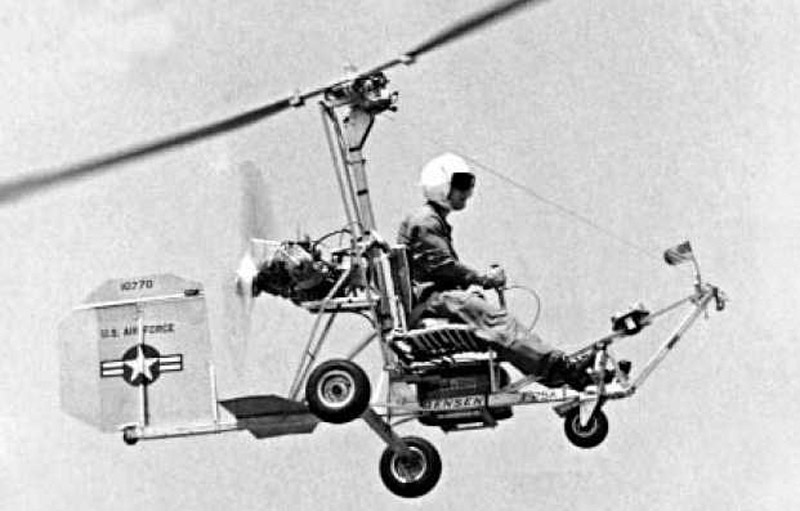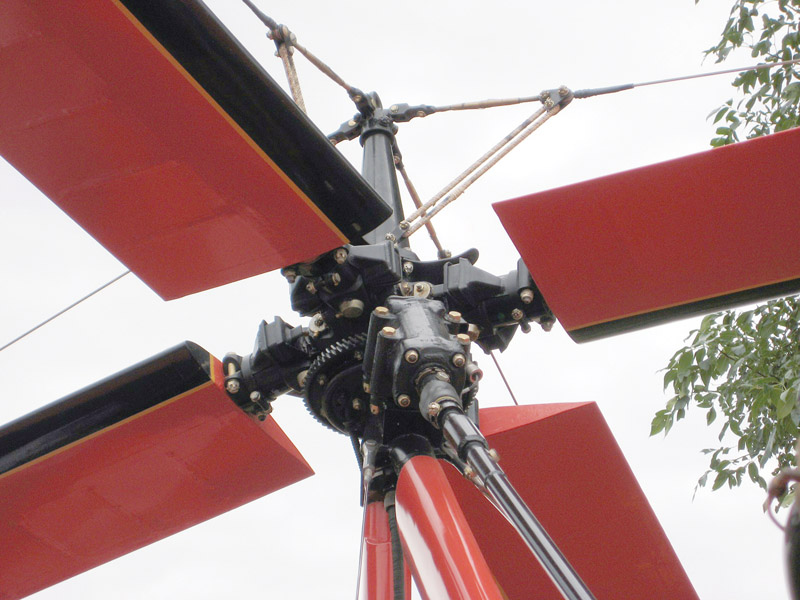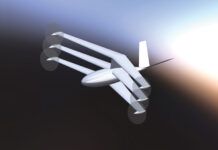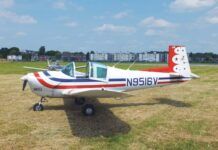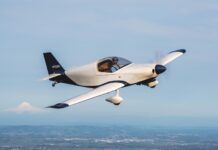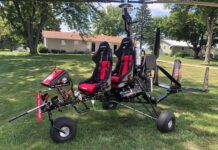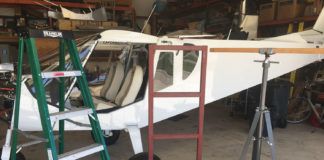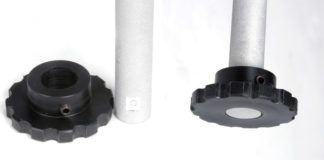Bensen B-8M on display at Newark Air Museum in Winthorpe, Nottinghamshire, England. (Photo: Alec Wilson [CC BY-SA 2.0 (http://creativecommons.org/licenses/by-sa/2.0)], via Wikimedia Commons)
Last month we started to look at gyroplanes. We continue now with some considerations about how the gyro compares with other recreational aircraft configurations, and how the features of the “modern” gyroplane affect flying qualities.
Early autogiros all had an airplane-like configuration. In essence they looked like conventional airplanes with a mast-mounted rotor replacing the wings. They had tractor-mounted engines and significant-sized tail surfaces at the back of the fuselage. Some concessions were made to rotor clearance in the design of the vertical fins, but overall the areas and moment arms of the tail were similar to airplanes.
Igor Bensen changed that when he introduced the Gyro-Copter. The original Bensen B-8m Gyro-Copter was an extremely minimalist machine. It was intended to be simple and inexpensive to build. The goal was to get into the air safely and cheaply.
The desired flight characteristics were like an ultralight. The Gyro-Copter was designed to fly slowly, on local flights in good weather. No thought was given to cross-country performance or drag reduction.
Unlike early autogyros, the Bensen was a pusher with the engine mounted to the back of the rotor mast. The engine was relatively high up the mast to move the propeller arc up enough to clear the keel that functioned as a tailboom.
There was a fin and rudder mounted to the back of the keel, but no horizontal tail other than a small flat-plate debris guard under the propeller. These configuration changes from the early autogiros had significant effects on flying qualities.
Like the Flying Flea (Pou du Ciel) before it, the Gyro-Copter was advertised as a low-cost, simple and safe way to get in the air. Like Henri Mignet with the Flea, Bensen believed that his configuration was safer than a conventional airplane because it was incapable of stalling and spinning. Stall/spin accidents were seen as the largest pilot-skill-related hazard to safe flight.
Bensen used the non-stalling/spin-proof characteristic of his craft to declare the Gyro-Copter to be a very safe form of flying machine. A contemporary Bensen advertisement in Popular Science reads “The Gyro-Copter: Easy to Build, Simplest, Safest to Fly.” Unfortunately, also like the Flea, the optimistic claim of being safer than conventional aircraft proved to be false.
Early autogyros like this Pitcairn looked like conventional airplanes with tractor-mounted engines and significant-sized tail surfaces at the back of the fuselage.
The NTSB database shows a total of 85 fatal Bensen Gyro-Copter accidents from 1966 to 2001. The 1960s were particularly bad, with 10 fatal accidents in 1967 and 11 in 1968. Many of these accidents followed a common history, as exemplified by an accident from July 1990. The NTSB report states:
“Several witnesses, all of which were gyrocopter pilots, stated that it appeared the pilot entered a pilot induced oscillation (PIO) during the initial climb and that he was unable to regain control.
“A video tape of the accident showed the aircraft enter a series of divergent nose up and nose down maneuvers, the first of which was a nose pitch up.
“The aircraft subsequently entered a steep descent, went inverted, and impacted the ground. No evidence of pre-impact failure or malfunction was found.”
In a sad parallel to the Pou, the Gyro-Copter successfully avoided the most feared characteristic of conventional airplanes (the tendency to stall and spin), only to fall victim to its own unique type of loss of control that appeared elsewhere in the flight envelope. Also like the original Pou du Ciel, once the problems were finally understood and fixed, the general type of aircraft found success.
On this Pitcairn autogyro, the mast-mounted rotor replaces the wings to generate lift. The free-spinning blades turn by autorotation.
Gyros vs. Trikes
Superficially, there are a lot of similarities between a trike and a gyrocopter. It’s easy to think of a gyro as a trike with the wing replaced by a rotor. Both are pushers supported by a lifting system mounted high above the center of gravity on a mast. Both are controlled in pitch by tilting the lifting system relative to the mast.
Zero-G No-No
Another similarity between trikes and gyroplanes is their intolerance of zero- or negative-G flight conditions. As we saw a few months ago, a trike is entirely dependent on having a positive load on the wing to be controllable, and becomes uncontrollable and unstable at negative G.
This situation is even more critical for a gyroplane. To maintain stability and provide lift, the rotor must always be spinning above a certain critical rpm. If rotor speed decays too much, the rotor will become unstable, and the blade flapping will become very large. When this happens, the blades are likely to fail or hit other parts of the gyroplane like the vertical fin. To keep the rotor in stable autorotation, it is essential to keep the plane of rotation at positive angle of attack, so the oncoming air flows upwards through the rotor disc.
If the rotor is unloaded, it cannot put any controlling force through the mast to trim or control the aircraft. Its rotation speed decays rapidly and will quickly drop below the critical speed at which the rotor becomes unstable. At this point the situation is unrecoverable.
This creates a problem for fixed-wing pilots transitioning into gyroplanes. Accident histories show that many gyro accidents start with a pull-up that leaves the aircraft nose up with rapidly decaying airspeed. The high drag of a gyroplane makes the loss of airspeed after a too-exuberant zoom more rapid than for a fixed-wing airplane.
A fixed-wing pilot is trained to unload the wing and reduce angle of attack to prevent a stall when in this kind of situation. This is exactly the wrong thing to do in a gyroplane. The right way to recover from this nose-high/low-airspeed condition in a gyro is to keep the stick back to keep the rotor loaded, allow the nose to settle as the airspeed decays, and then gently push forward to accelerate again. The gyro may develop a high descent rate during the recovery, but the rotor will maintain its rpm and continue to lift.
A fixed-wing pilot will react by pushing forward hard on the stick to arrest the loss of airspeed. This will unload the rotor and lead to a high probability of decaying rotor rpm and excessive blade flapping, which will likely cause either loss of control, or a blade strike on the aft portion of the fuselage. Either of these events will prove catastrophic.
Differences from Trikes
While the similarities between trikes and gyros are significant, the difference between the two types is critical. The wing of a trike is held in a constant position relative to the body by the control bar, and the trike wing is not free to yaw about the mast attach point. This means that in addition to transmitting lift through the mast, the trike wing also exerts pitching, rolling, and yawing moments directly on the rest of the aircraft in response to aerodynamic forces on the wing.
This means that as long as the pilot holds the control bar, the wing and body tend to pitch, roll, and yaw as a unit. If a gust perturbs the wing, both the wing and body move together, and the pilot gets a pitch-rate cue that matches what’s happening to the wing.
It also means that the pitching moment generated by the wing helps trim the aircraft, and the natural directional stability of the wing stabilizes the whole machine in yaw.
A gyroplane rotor cannot transmit moment down the mast. Blade flapping or teetering for a two-blade rotor allow the rotor to pitch and roll independently of the body. Since the rotor spins about the rotor shaft axis, it does not transmit yawing moment down the mast either. The only force transmitted to the rest of the aircraft by the rotor is the normal force acting perpendicular to the plane of rotation of the blades (otherwise known as the “tip path plane”).
Because of this, the rotor and the body of a gyroplane are really two loosely coupled systems that can move independently of each other.
The pilot’s stick commands the tilt of the rotor tip path plane relative to the body. In steady-state flight in perfectly calm conditions, the rotor’s plane of rotation stays where it is commanded by the stick, but because of blade flapping or teetering, the rotor can pitch about the commanded position if it is perturbed by a gust.
The rest of the gyroplane (the body) hangs from the rotor head. If it has no horizontal tail (as was the case for the Bensen, and many that followed), it is essentially a pendulum hung from the rotor. The rotor exerts some control over the attitude of the body by tilting the rotor thrust vector relative to the mast, but does not directly trim the body. Because the body is free to pitch relative to the rotor, there is no aerodynamic damping or stabilization of the body in pitch from the rotor, and the stability and attitude of the body are dependent on the “pendulum effect.”
These factors give gyroplanes stability and control modes that are not present in fixed wing airplanes as the body and rotor move semi-independently and interact.
Next month we will look in detail at how these affect stability and controllability of the gyro, and how some configuration features have been defined to greatly improve the flying qualities over the classic Bensen.

